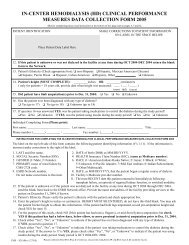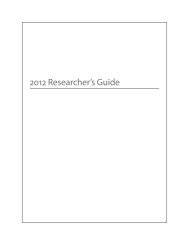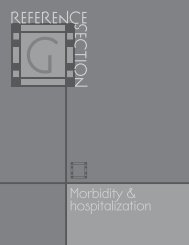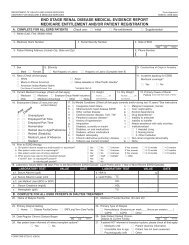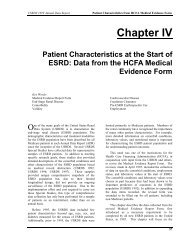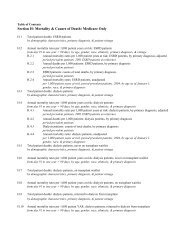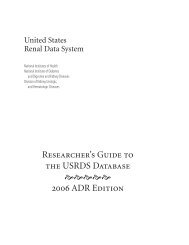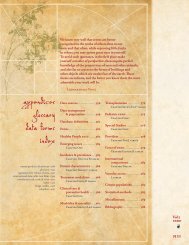(2010) USRDS 2010 - United States Renal Data System
(2010) USRDS 2010 - United States Renal Data System
(2010) USRDS 2010 - United States Renal Data System
Create successful ePaper yourself
Turn your PDF publications into a flip-book with our unique Google optimized e-Paper software.
<strong>2010</strong><br />
usrds<br />
annual<br />
data<br />
report<br />
volume<br />
��� ckd<br />
page<br />
��<br />
disease (CKD), defining its burden in the general population, and looking<br />
a surveillance<br />
system coordinated<br />
by the National<br />
Center for Health Statistics at<br />
at cardiovascular and other comorbidities, adverse events, preventive the Centers for Disease Control and<br />
care, prescription medication therapy, care during the transition Prevention. The conceptual model of this<br />
to ESRD, and costs to Medicare and employer group health system was based on similar approaches for<br />
plans. In Volume Two we provide information on the size populations at risk for diabetes and hypertension,<br />
and impact of the end-stage renal disease (ESRD) popu- two well-known diseases that damage the kidney as<br />
lation — the traditional focus of the <strong>USRDS</strong> — pre- well as other organ systems. The model characterizes<br />
senting an overview of the ESRD program, along progressive stages of CKD, from early evidence of kidney<br />
with detailed data on incidence, prevalence, damage — such as albumin in the urine — to overt reductions<br />
comorbidity of new ESRD patients, severity in the filtering capacity of the kidney, defined by the estimated<br />
of disease, clinical care, hospitalization and glomerular filtration rate (eGFR).<br />
mortality rates, pediatric patients, renal There are many issues related to defining the levels of eGFR and<br />
transplantation, the provider delivery urine albumin which indicate “true disease” in the kidney during the<br />
system, and the economics of the early stages of CKD, as compared to a normal reduction in kidney fil-<br />
ESRD program.<br />
tering capacity, particularly in the elderly. A new estimating equation was<br />
We approach Volume One published in the Annals of Internal Medicine in May, 2009, improving on<br />
from the perspective that the the MDRD method; we compare these two equations, providing a perspective<br />
implications of CKD were un- for readers on the strengths and weaknesses of each. The <strong>USRDS</strong> and others will<br />
der-appreciated prior to Feb- continue to investigate these issues in both the clinical and public health arenas,<br />
ruary, 2002, when a new but already there is important data available on the impact of CKD, data based not<br />
CKD classification staging only on biochemical information, but on the disease as defined within the Medicare<br />
system was proposed. and health plan datasets. The impact of the CKD staging system as a predictor of mor-<br />
The five-stage system bidity and mortality is now well known on a population level, but its translation into<br />
was developed using the care of individual patients is another matter.<br />
population-level data The 2008 ADR was the first to include a volume dedicated to CKD; this year we expand<br />
from the National the volume to ten chapters, including an analysis of acute kidney injury as well as a chapter<br />
Health and Nutri- on cardiovascular disease. New this year is a chapter on the transition between CKD and<br />
tion Examination ESRD in nursing home patients, and analyses of medication use under the Part D prescrip-<br />
Survey (NHANES), tion drug benefit, which began in 2006.<br />
j ����������������������������������������������������������������<br />
�����������������������������������������������������������<br />
�����������������������������������������������������<br />
introduction to volume one � ckd




